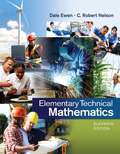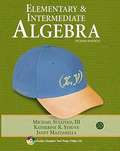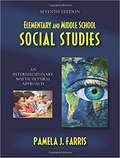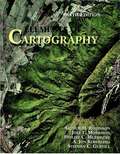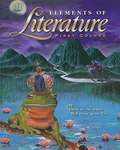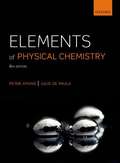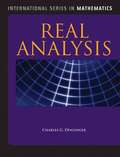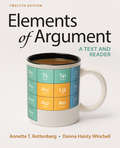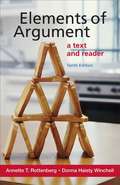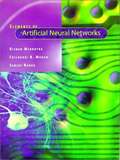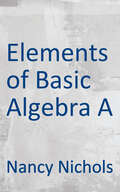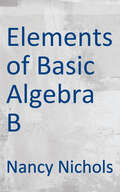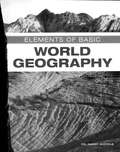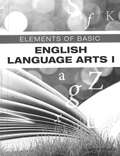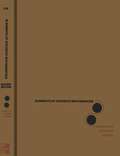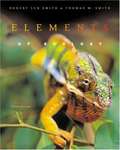- Table View
- List View
Elementary Technical Mathematics
by Dale Ewen C. Robert NelsonELEMENTARY TECHNICAL MATHEMATICS Eleventh Edition is written to help students with minimal math background successfully prepare for technical, trade, allied health, or Tech Prep programs. The authors focus on fundamental concepts in basic arithmetic including the metric system and measurement, algebra, geometry, trigonometry, and statistics, which are supported by thousands of examples, exercises, and applications surrounding such fields as industrial and construction trades, electronics, agriculture/horticulture, allied health, CAD/drafting, HVAC, welding, auto/diesel service, aviation, natural resources, culinary arts, business/personal finance, and others. For this revision, the authors have added over 150 new exercises, 30 new examples, new applications categories, and a new appendix on simple inequalities. The goal of ELEMENTARY TECHNICAL MATHEMATICS is to engage students and provide them with the math background they need to succeed in future courses and careers.
Elementary and Intermediate Algebra (2nd Edition)
by Katherine R. Struve Janet Mazzarella Michael Sullivan IIIThe Sullivan/Struve/Mazzarella Algebra Series was written to motivate students to "do the math" outside of the classroom through a design and organization that models what you do inside the classroom. The left-to-right annotations in the examples provide a teacher's voice through every step of the problem-solving process. The Sullivan exercise sets, which begin with Quick Checks to reinforce each example, present problem types of every possible derivation with a gradual increase in difficulty level. The new "Do the Math" Workbook acts as a companion to the text and to MyMathLab®by providing short warm-up exercises, guided practice examples, and additional "Do the Math" practice exercises for every section of the text. Operations on Real Numbers and Algebraic Expressions; Equations and Inequalities in One Variable; Introduction to Graphing and Equations of Lines; Systems of Linear Equations and Inequalities; Exponents and Polynomials; Factoring Polynomials; Rational Expressions and Equations; Roots and Radicals; Quadratic Equations; Graphs of Quadratic Equations in Two Variables and an Introduction to Functions. For all readers interested in beginning algebra.
Elementary and Middle School Mathematics: Teaching Developmentally
by John A. Van de Walle Karen S. Karp Jennifer M. Bay Williams"It is fun to figure out the puzzle of how children go about making sense of mathematics and then how to help teachers help kids. " John A. Van de Walle, Late of Virginia Commonwealth University This is the philosophy behindElementary and Middle School Mathematics: Teaching Developmentally. John A. Van de Walle wrote this book to help students understand mathematics and become confident in their ability to teach the subject to children in kindergarten through eighth grade. Although he could not have foreseen the changes in mathematics teaching over the last three decades, he was at the forefront of the movement towards a constructivist view of teaching, or teaching developmentally. Constructivism says that children construct their own knowledge. They are not blank slates waiting to absorb whatever the teacher tells them. Teachers must understand both mathematics itself and how students learn mathematics in order to teach it effectively. Learning through problem solving is another major theme of this book. Students solve problems not just to apply mathematics, but also to learn new mathematics. Effective problems will take into account where students are, the problematic or engaging aspect of the problem must be due to the mathematics that the students are to learn and not be diluted by non-mathematical activities such as cutting or pasting, and the problem must require justifications and explanations for answers and methods. Learning then becomes an outcome of the problem solving process. The book also addresses in more detail than any other book on the market the effect that the trends of standards-based education, increased pressure to test, and increased teacher accountability have had on teaching mathematics. He addresses the 2000 NCTM Standards in depth, in Chapter 1 on Teaching Mathematics in the Era of the NCTM Standards, through the NCTM icon that appears in the margins throughout the text, and in two appendices in the back of the book. Chapter 5 on Building Assessment into Instruction has also been heavily revised to focus on increased testing pressure, creating more explicit links between objectives and assessment, and including assessments for students with special needs. Elementary and Middle School Mathematics: Teaching Developmentallyis a book for doing math today-for both students who want to become teachers, and the students they will eventually teach. New To This Edition: NEW! Revises Chapter 5 on assessment--Discusses increased testing pressure and accountability, adds more information on equitable assessments, creates more explicit links between objectives and assessment, and includes assessments for students with special needs. NEW! Updates theLiterature Connectionsfeature to remove all out of print children's literature and include more non-fiction, poetry, and other types of readings. NEW! Weaves theFocal Pointsthroughout the chapters as well as links them with theBig Ideasfeature-Focal Pointshave also been added to the Appendix. NEW! Includes expanded coverage of working with diverse learners. NEW! Gives greater emphasis on dealing with math anxiety.
Elementary and Middle School Social Studies: An Interdisciplinary, Multicultural Approach
by Pamela J. FarrisThe latest edition of Pamela Farris's popular, value-priced text continues to offer pre- and in-service teachers creative strategies and proven techniques sensitive to the needs of all elementary and middle school learners. Coverage includes the C3 Framework and the four sets of learning from the National Curriculum Standards for Social Studies. Farris, together with contributors who specialize in implementing successful teaching methods and theories, demonstrate how classroom teachers can excite and inspire their students to be engaged learners.
Elements Of Accounts (Part 1) class 11 - GSTB
by Gujarat State Board of School TextbooksThe Gujarat Secondary and Higher Secondary Board has prepared new syllabi in accordance with the syllabi at the national level. These syllabi are approved by the Government of Gujarat. The Gujarat State Board of School Textbooks takes pleasure in presenting this textbook to the students. It is prepared according to the new syllabus of Elements of Accounts (Part 1) for Standard 11. This textbook is written and reviewed by expert teachers and professors. This textbook is published after incorporating the necessary changes suggested by the reviewers.
Elements Of Accounts (Part 2) class 11 - GSTB
by Gujarat State Board of School TextbooksThe Gujarat Secondary and Higher Secondary Board has prepared new syllabi in accordance with the syllabi at the national level. These syllabi are approved by the Government of Gujarat. The Gujarat State Board of School Textbooks takes pleasure in presenting this textbook to the students. It is prepared according to the new syllabus of Elements of Accounts (Part 2) for Standard 11. This textbook is written and reviewed by expert teachers and professors. This textbook is published after incorporating the necessary changes suggested by the reviewers.
Elements Of Cartography
by Arthur H. Robinson Joel L. Morrison Phillip C. Muehrcke A Jon. Kimerling Stephen C. Guptill A. Jon KimerlingElements of Cartography, 6e continues its reputation as the market leader by integrating the latest in modern technology with traditional cartographic principles.
Elements Of Ecology (Ninth Edition)
by Robert Leo Smith Thomas M. SmithElements of Ecology, Ninth Edition continues to explain ecological processes clearly and concisely, with a greater emphasis on the relevance of ecology to everyday life and the human impact on ecosystems. This dramatically revised edition discusses issues of human ecology throughout the text and provides a greater variety of opportunities for students to learn, practice, and develop quantitative and analytical skills.
Elements Of Language: Grammar, Usage and Mechanics - Language Skills Practice for Chapters 10-26
by Holt Rinehart Winston StaffMost of the worksheets you will find in this workbook are traditional worksheets providing practice and reinforcement activities on every rule and on all major instructional topics in the grammar, usage, and mechanics chapters in Elements of Language.
Elements Of Literature Fourth Course
by Holt Rinehart WinstonThe authors of this have established the literary framework of the Elements of Literature program and developed instructional materials for the elements of drama, poetry, and fiction in the book.
Elements Of Literature, First Course
by Judith L. Irvin Robert E. Probst Robert Anderson John Malcolm Brinnin John LeggettLanguage arts textbook.
Elements Of Physical Chemistry
by David Smith Peter Atkins Julio De PaulaGetting to grips with physical chemistry can be a daunting task. With new concepts to understand and a large amount of mathematics to master, it is no wonder that students can sometimes find it overwhelming. Elements of Physical Chemistry has been carefully developed to help students increase their confidence when using physics and mathematics to answer fundamental questions about the structure of molecules, how chemical reactions take place, and why materials behave the way they do. New to this edition: A new Foundations chapter introduces the topics that are needed to understand the principles later in the text, such as classical mechanics and electromagnetism. Chemist's toolkits are used throughout the text to remind students of a variety of mathematical techniques or introductory chemistry needed to follow material in the chapters. Labels are attached to all the main equations to help students recall their meaning and relevance New Road Maps provide a structured summary of equations, showing the relations between expressions.
Elements Of Real Analysis (G - Reference, Information And Interdisciplinary Subjects)
by Charles G. DenlingerElementary Real Analysis is a core course in nearly all mathematics departments throughout the world. It enables students to develop a deep understanding of the key concepts of calculus from a mature perspective. Elements of Real Analysis is a student-friendly guide to learning all the important ideas of elementary real analysis, based on the author's many years of experience teaching the subject to typical undergraduate mathematics majors. It avoids the compact style of professional mathematics writing, in favor of a style that feels more comfortable to students encountering the subject for the first time. It presents topics in ways that are most easily understood, without sacrificing rigor or coverage. In using this book, students discover that real analysis is completely deducible from the axioms of the real number system. They learn the powerful techniques of limits of sequences as the primary entry to the concepts of analysis, and see the ubiquitous role sequences play in virtually all later topics. They become comfortable with topological ideas, and see how these concepts help unify the subject. Students encounter many interesting examples, including "pathological" ones, that motivate the subject and help fix the concepts. They develop a unified understanding of limits, continuity, differentiability, Riemann integrability, and infinite series of numbers and functions.
Elements of Accounts Part 1 class 12 - GSTB
by Gujarat State Board of School TextbooksThe Gujarat State Board of School Textbooks takes pleasure in presenting this textbook to the students. It is prepared according to the new syllabus of Elements of Accounts (Part 1) for Standard 12. This textbook is written and reviewed by expert teachers and professors. This textbook is published after incorporating the necessary changes suggested by the reviewers.
Elements of Accounts Part 2 class 12 - GSTB
by Gujarat Sate Board of School TextbooksThe book published by the Gujarat State Board of Textbooks for class 12 has been written in a simple English language keeping in view the standard of class 12 students. This book will also be of great use to those students who are just beginning to learn the subject of Accountancy. A number of illustrations have been given in each chapter and these have been solved in such a simple manner that students can easily understand them. Practical questions given at the end of each chapter are strictly in the serial order of the illustrations. Answers and hints to solve the questions have been given at the end of each question. We are very much confident that after doing the illustrations, students can themselves solve the practical questions. The book contains essay-type, short-anwer type, objective type and practical questions at the end of each chapter so that students may test their understanding of the chapter.
Elements of Argument
by Annette T. Rottenberg Donna Haisty WinchellElements of Argument teaches students how to approach, develop, and defend arguments one element at a time. This comprehensive, accessible text carefully scaffolds argument for students, explaining approaches to argumentation, (including Aristotelian, Toulmin, and Rogerian models as well as Stasis Theory questions), critical reading, and argument analysis. The major components of argumentation--claims, support, assumptions, logic--are explained in depth, and a robust research section shows students how to find, incorporate, and build on existing arguments. This Twelfth Edition has also been updated with more sourced readings than ever before, further reinforcing the importance of research and synthesis. Finally, the anthology includes debates and casebooks on unsettled current issues as well as timeless, classic arguments, making Elements of Argument a comprehensive resource for the argument classroom.
Elements of Argument: A Text And Reader (Tenth Edition)
by Annette T. Rottenberg Donna Haisty WinchellElements of Argument combines a thorough argument text on critical thinking, reading, writing, and research with an extensive reader on both current and timeless controversial issues. It presents everything students need to analyze, research, and write arguments. Elements of Argument covers Toulmin, Aristotelian, and Rogerian models of argument and has been thoroughly updated with current selections students will want to read. It now includes additional support for academic writing, making it a truly flexible classroom resource. An electronic edition is available at half the price of the print book. Read the preface.
Elements of Artificial Neural Networks
by Kishan Mehrotra Chilukuri K. Mohan Sanjay RankaElements of Artificial Neural Networks provides a clearly organized general introduction, focusing on a broad range of algorithms, for students and others who want to use neural networks rather than simply study them. The authors, who have been developing and team teaching the material in a one-semester course over the past six years, describe most of the basic neural network models (with several detailed solved examples) and discuss the rationale and advantages of the models, as well as their limitations. The approach is practical and open-minded and requires very little mathematical or technical background. Written from a computer science and statistics point of view, the text stresses links to contiguous fields and can easily serve as a first course for students in economics and management. The opening chapter sets the stage, presenting the basic concepts in a clear and objective way and tackling important--yet rarely addressed--questions related to the use of neural networks in practical situations. Subsequent chapters on supervised learning (single layer and multilayer networks), unsupervised learning, and associative models are structured around classes of problems to which networks can be applied. Applications are discussed along with the algorithms. A separate chapter takes up optimization methods. The most frequently used algorithms, such as back propagation, are introduced early on, right after perceptrons, so that these can form the basis for initiating course projects. Algorithms published as late as 1995 are also included. All of the algorithms are presented using block-structured pseudo-code, and exercises are provided throughout. Software implementing many commonly used neural network algorithms is available at the book's website. Transparency masters, including abbreviated text and figures for the entire book, are available for instructors using the text.
Elements of Basic World Geography
by Nancy NicholsElements of Basic World Geography by Nancy Nichols
Elements of Basic: English Language Arts I
by Nancy NicholsElements Of Basic English Language Arts I
Elements of Discrete Mathematics - Second Edition
by C L LiuElements of Discrete Mathematics, Second Edition" by C. L. Liu is a comprehensive and accessible textbook that explores fundamental concepts in discrete mathematics. The book covers topics such as logic, set theory, combinatorics, graph theory, and mathematical induction, providing a solid foundation for students studying computer science, engineering, or mathematics. The author emphasizes clear explanations and examples to help readers grasp abstract concepts, making it suitable for both beginners and those seeking a deeper understanding of the subject. With its practical applications in computer science and information technology, the book serves as an essential resource for students and professionals alike, fostering a strong understanding of discrete mathematical structures and their significance in various disciplines.
Elements of Ecology 5th Edition
by Robert Leo Smith Thomas M. SmithWith a modular organization and a beautiful four color art program, the fourth edition of this leading text for non-majors continues to provide a clear presentation of the principles of ecology and illustrate their relation to today's environmental issues. Far-reaching in its coverage, the fourth edition provides the most up-to-date information with a new chapter on global warming and deforestation. It also focuses on ecology as a science, providing the basic background information needed to show the relevance of studying environmental problems on a global scale.
Elements of Educational Psychology (5th edition)
by Hans Raj BhatiaHomeostasis, social behaviour, abnormal behaviour, culture, studies of environmental influence, affection and security form part of Elements of Educational Psychology syllabus for college.
